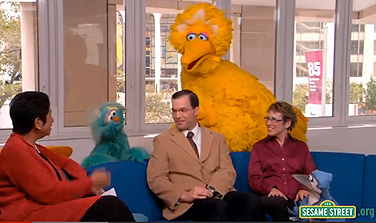News
Ostrov takes anti-bullying message
to Sesame Street audience

UB psychologist Jamie Ostrov appears in a series of web-based videos aimed at helping parents talk about bullying with their pre-schoolers.
-
 Print
Print -
 Comments
Comments
-

Jamie Ostrov talks to Rosarita about handling bullying behavior.Watch a video.
Jamie M. Ostrov’s work on understanding how bullying behavior develops in pre-school children has won him some influential admirers and boosters.
An associate professor of psychology at UB, Ostrov also is a consultant for the Centers for Disease Control and Prevention, and the U.S. Department of Education in their efforts to develop a uniform definition of bullying. He’s assisted the federal StopBullying.gov initiative in adapting bullying-prevention materials for young children.
And add this recent achievement to Ostrov’s professional dossier: an October appearance opposite Big Bird and his furry friends, counseling the “Sesame Street” characters on what to do when confronted with bullying behavior. Ostrov is featured in a series of web-based videos to accompany a recent episode of the new season of “Sesame Street.” The series also is available on DVD.
“I wanted to join a club called the Good Birds Club,” Big Bird tells Ostrov in the video. “They didn’t want me because my beak was too long and I was too big and too yellow.”
When Ostrov suggests to Big Bird and friends that they find a grown-up and report what has happened, the blue muppet named Rosita worries about being labeled a tattletale.
“Oh no, Rosita. That’s not tattling,” reassures Ostrov. “That’s reporting. Reporting is important when our friends are hurt. It’s important to find a grown-up to report it so our friends can stay safe.”
“Essentially, my research is geared towards preschoolers, which is the target audience of ‘Sesame Street,’” explains Ostrov, a developmental psychologist who also was a consultant to the Children’s Television Workshop for its bullying prevention initiative.
“Their messages—teaching children how to identify what bullying is and what to do if it happens to them, such as seeking assistance from adults—are consistent with our intervention program that addressed aggressive behavior in preschool classrooms and that also used developmentally appropriate puppets, stories and activities.”
“‘Sesame Street’ works very hard to keep the message developmentally appropriate and consistent with current research evidence, as well as best practices in the field,” Ostrov says. “My role was to provide both the developmental perspective, as well as assist with the current understanding of how bullying is defined by scholars.”
Ostrov’s research centers around understanding the development of types of aggression in children ages 3 to 5. One of those subtypes of aggressive behavior is bullying. All bullying is aggressive behavior, Ostrov explains, but not all aggressive behavior is bullying.
His research addresses what Ostrov calls “forms and functions” of aggressive behavior. “Forms” of aggression are ways aggression is displayed. “Functions” are the reasons why children behave in aggressive ways.
“Distinguishing between the various forms and functions of aggression has important implications for understanding the development of aggression and bullying in children,” Ostrov says.
His research also examines the developmental origins, processes and outcomes of physical and relational aggression (e.g., social exclusion) in children and adolescents. Some of this work has documented the processes or mechanisms by which aggression and peer victimization are linked across development.
Previous studies in the Social Development Laboratory in the UB Department of Psychology, which Ostrov directs, have shown that children who are victimized by their peers become aggressors over time, and that the type of victimization they experience predicts the type of aggression they display with their peers over time.
“Thus, children are likely learning from peer-victimization experiences how to become an aggressor,” says Ostrov. He believes that with UB’s new Jean M. Alberti Center for the Prevention of Bullying Abuse and School Violence, the university is well-positioned to become a leading institution in the field.

Reader Comments